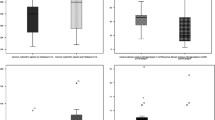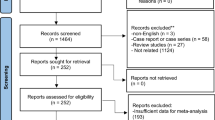Abstract
Purpose
To explore the dose response to onabotulinumtoxinA 50, 100, and 200 U in patients with spinal cord injury (SCI) with urinary incontinence (UI) due to neurogenic detrusor overactivity (NDO).
Methods
Patients (N = 73) with SCI (level T1 or lower) with NDO and UI (≥14 UI episodes/week) received 30 intradetrusor injections of onabotulinumtoxinA (50 U [n = 19], 100 U [n = 21], or 200 U [n = 17]) or placebo (n = 16) via cystoscopy, avoiding the trigone. Changes from baseline in UI episodes/week, volume voided/micturition, maximum cystometric capacity, and maximum detrusor pressure (MDP) during first involuntary detrusor contraction (IDC) were evaluated. Adverse events (AEs) were assessed.
Results
A significant linear dose response for UI episodes/week was identified at weeks 18, 30, 36, 42, and 54 (P < 0.05) with a similar trend (P = 0.092) at week 6 (primary time point). A significant linear dose response was observed in volume/void at all post-treatment time points up to week 54 (P < 0.05) and in MDP during first IDC at week 6 (P = 0.034). The proportion of patients who achieved continence at week 6 was highest in the 200 U group. Duration of effect was longest with the 200 U dose, compared with other treatment groups. The AEs were comparable across groups; urinary tract infection was the most common AE across all treatment groups.
Conclusions
In this exploratory dose–response study of SCI patients with UI due to NDO, onabotulinumtoxinA 200 U was the most effective dose. The AE profile was comparable across all groups.

Similar content being viewed by others
Notes
Units of biological activity of onabotulinumtoxinA cannot be compared to or converted into units of any other botulinum toxin product, and onabotulinumtoxinA is not interchangeable with other botulinum toxin preparations.
References
Schurch B, Stohrer M, Kramer G, Schmid DM, Gaul G, Hauri D (2000) Botulinum-A toxin for treating detrusor hyperreflexia in spinal cord injured patients: a new alternative to anticholinergic drugs? Preliminary results. J Urol 164(3 Pt 1):692–697
Mangera A, Andersson KE, Apostolidis A, Chapple C, Dasgupta P, Giannantoni A, Gravas S, Madersbacher S (2011) Contemporary management of lower urinary tract disease with botulinum toxin A: a systematic review of botox (onabotulinumtoxinA) and dysport (abobotulinumtoxinA). Eur Urol 60(4):784–795
Cruz F, Herschorn S, Aliotta P, Brin M, Thompson C, Lam W, Daniell G, Heesakkers J, Haag-Molkenteller C (2011) Efficacy and safety of onabotulinumtoxinA in patients with urinary incontinence due to neurogenic detrusor overactivity: a randomised, double-blind, placebo-controlled trial. Eur Urol 60(4):742–750
Ginsberg D, Gousse A, Keppenne V, Sievert KD, Thompson C, Lam W, Brin M, Jenkins B, Haag-Molkenteller C (2012) Phase 3 efficacy and tolerability study of onabotulinumtoxinA in patients with urinary incontinence resulting from neurogenic detrusor overactivity. J Urol 187(6):2131–2139
Karsenty G, Denys P, Amarenco G, De Seze M, Game X, Haab F, Kerdraon J, Perrouin-Verbe B, Ruffion A, Saussine C, Soler JM, Schurch B, Chartier-Kastler E (2008) Botulinum toxin A (Botox) intradetrusor injections in adults with neurogenic detrusor overactivity/neurogenic overactive bladder: a systematic literature review. Eur Urol 53(2):275–287
Weld KJ, Dmochowski RR (2000) Association of level of injury and bladder behavior in patients with post-traumatic spinal cord injury. Urology 55(4):490–494
Stoehrer M, Wolff A, Kramer G, Steiner R, Lmochner-Ernst D, Leuth D, Steude U, Ruebben H (2009) Treatment of neurogenic detrusor overactivity with botulinum toxin A: the first seven years. Urol Int 83(4):379–385
Giannantoni A, Mearini E, Del Zingaro M, Porena M (2009) Six-year follow-up of botulinum toxin A intradetrusorial injections in patients with refractory neurogenic detrusor overactivity: clinical and urodynamic results. Eur Urol 55(3):705–711
Manack A, Motsko SP, Haag-Molkenteller C, Dmochowski RR, Goehring EL Jr, Nguyen-Khoa BA, Jones JK (2011) Epidemiology and healthcare utilization of neurogenic bladder patients in a US claims database. Neurourol Urodyn 30(3):395–401
Schurch B, de Seze M, Denys P, Chartier-Kastler E, Haab F, Everaert K, Plante P, Perrouin-Verbe B, Kumar C, Fraczek S, Brin MF (2005) Botulinum toxin type A is a safe and effective treatment for neurogenic urinary incontinence: results of a single treatment, randomized, placebo controlled 6-month study. J Urol 174(1):196–200
Acknowledgments
The authors acknowledge the contributions of principal investigators in each country. Serbia: M. Lazic, A. Milosevic, and C. Tulic; Greece: A. Apostolidis, A. Athanasopoulos, and F. Sofras; Turkey: F. Demirel, C. Ozyurt, B. Seckin, and T. Tarcan; Egypt: I. Hafeez and S. Mourad; India: G. Mathew, P. Murthy, H. Nagaraj, H. Pathak, R. Shimpi, S. Shroff, K. Shukla, and S. Sinha. Writing assistance for manuscript development was provided by Jaya Kolipaka of Evidence Scientific Solutions and funded by Allergan, Inc. Apostolos Apostolidis is an investigator for Allergan, Inc., Astellas Pharma, Inc., Pfizer Inc, Pharmaserve-Lilly, and GlaxoSmithKline. He is a consultant for Allergan, Inc. and Astellas Pharma, Inc., and has received lecturer honoraria from Allergan, Inc., Astellas Pharma, Inc., and Pfizer Inc, and investigator-initiated research grants from Astellas Pharma, Inc. and Pfizer Inc. Sherif Mourad is on the consultant board for Pfizer AfME Group and has received lecturer honoraria from Pfizer Inc and investigator-initiated research grants from Allergan, Inc. and Pfizer Inc. Catherine Thompson and Xiaohong Yan are employees of Allergan, Inc.
Conflict of interest
This study was funded by Allergan, Inc.
Author information
Authors and Affiliations
Corresponding author
Electronic supplementary material
Below is the link to the electronic supplementary material.
Rights and permissions
About this article
Cite this article
Apostolidis, A., Thompson, C., Yan, X. et al. An exploratory, placebo-controlled, dose–response study of the efficacy and safety of onabotulinumtoxinA in spinal cord injury patients with urinary incontinence due to neurogenic detrusor overactivity. World J Urol 31, 1469–1474 (2013). https://doi.org/10.1007/s00345-012-0984-0
Received:
Accepted:
Published:
Issue Date:
DOI: https://doi.org/10.1007/s00345-012-0984-0




